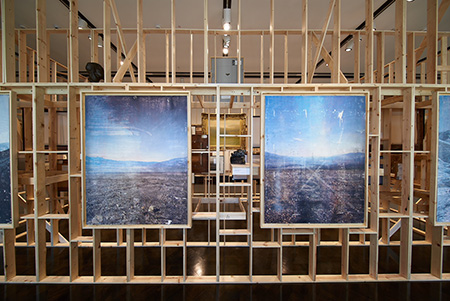
Continuing through August 5, 2018
Los Angeles-based artist Rodrigo Valenzuela’s installation, “Work in its Place,” first withholds, then confounds, and finally intrigues. We first see an open-beamed, barn-like structure, which has paintings, sculptures, and photographs (all drawn from JSMA’s collection of American art) displayed inside. Searching for its entrance, we discover there is none; we can only peek through the slats, catching partial glimpses from obstructed angles. The structure’s exterior — 30 feet long, 18 feet wide, 18 feet high — is hung with Valenzuela’s own photographs of Death Valley, highly distressed through scraping and other manual techniques.
The exhibition’s head-scratching conceit begins to make sense when you learn the artist is critiquing the institution of museums as bastions of white male privilege: the wealthy patrons, the curatorial bias, and the predominantly male-dominated stratum of artists exhibited in those august halls. The installation places viewers on the outside of this exclusive world, looking in, wondering why the Hudson River School landscapes and imagery of the Great American West — presented within a structure resembling a Western-town façade in a John Ford movie — seems so inaccessibly remote. Valenzuela’s stark Death Valley photos do not glow with the honeyed, idealized light of Hollywood sunsets or Frederic Remington paintings; they are as inhospitable as the moon. Or a refugee camp. For disenfranchised populations, the artist implies, the mythos of the American West — indeed of the American Dream — remains barely visible and wholly ungraspable.
